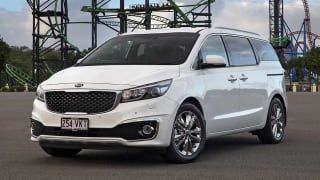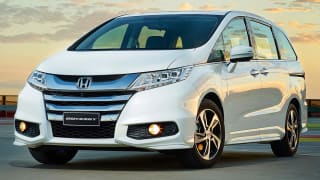Rivals are the biggest obstacle for Citroen's typically clever seven-seater. If the Citroen Grand C4 Picasso was built by Toyota it would be a world-beater.
It looks surprisingly good, it drives well and it has all sorts of surprising and enjoyable little design tweaks and treats. A night light for fold-down play trays in the second-row seats is just one.
The Citroen is also priced reasonably sharply, from $40,990 as a five-seater ($44,990 with seven) and gives the space and comfort that many people are chasing — and often not finding — in a family-sized SUV.
But the Picasso is not a Toyota and so only 30 are finding new homes in Australia each month, two-thirds of them with the full cabin package. That's a tiny number, even for a brand that's still best-known as French and quirky despite giant efforts to ease into the mainstream of motoring.
For perspective, the Kia Carnival and Honda Odyssey are currently the top choices in the class and each tallies more than 350 monthly sales.
Driving the Picasso shows that Citroen knows how to do good cars but closer scrutiny throws up too many silly things. And those mean questions and doubts, and doubts stop people from buying.
For a start, the five-seater Picasso is officially classified as a small hatch. Yet it is clearly a giant box-on-wheels for families, not something you'd shop against a Toyota Corolla or Mazda3.
The seven-seater at least makes the grade as a people-mover, even if it's only about 15cm longer, but I have to wonder about the long-term quality and the service back-up. There are plastic parts in the cabin that look and feel flimsy and the overall ambience is some way behind the Odyssey and recently updated Carnival.
The 2.0-litre diesel engine has good pulling power but do families — and women in particular — understand the advantages over petrol or want to deal with the oddball refuelling, often away from the unleaded pumps?
Citroen is doing what it can to answer the questions, even developing a unique six-year warranty in Australia with capped-price servicing. For a time it was best overall on the warranty front, before Kia hit showrooms with its latest seven-year package.
But let's drop the doubts and look at the car, concentrating on the "real" conveyance.
I've driven both the Picasso and Grand Picasso, with petrol and diesel engines, and like them. I like them a lot. They're big boxes but there is enough style to move them away from something like a Hyundai iMax and the equipment is good.
The Grand Picasso is a seven-seater with flexibility and choices in the seating, from the arm rests on the front buckets through to third-row seats that disappear to create a usable flat floor. The mid-row seats also slide and have multi-function folding.
As a driver, the Grand is well short of a sports car but not as cumbersome as a lot of SUVs
Access is good even without sliding side doors, and the hinged-door design makes the Grand more car-like for kids who can struggle with hefting a sliding door. The electric tailgate gets a tick.
As a driver, the Grand is well short of a sports car but not as cumbersome as a lot of SUVs. The turning circle is just plain brilliant, making most parking a breeze.
The view out the front is brilliant, too, with no impediments to vision. The windscreen is giant, and there are even sliding sun visors which take in the glass area up over my head, and the layout to the side means no blind spots.
The performance is good, although more solid than spritely, and the Grand cruises easily and very quietly on highways. The automatic gearbox is unobtrusive, although I'm no fan of the selector stalk, which feels flimsy and is easily confused with the turn indicator or bumped while using the wiper switch.
The central instrument pod is nicely futuristic and I like the ability to customise both the look and the various sounds. It's very Citroen.
The seats could do with more shape and a cushier feel but I have no questions about their long-distance comfort.
















